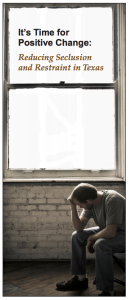It’s Time for Positive Change
Reducing Seclusion and Restraint in Texas
Changing policies and practices in Texas Reducing seclusion and restraint leads to fewer staff and consumer injuries and deaths. It has been linked to less use of sick time, lower staff turnover, and fewer workers’ compensation claims. Facilities that use seclusion and restraint as a last resort are better able to create patient-centered, trauma-informed care environments that lead to more positive outcomes for consumers and service providers.
Reducing seclusion and restraint in Texas is possible with changes in policies, procedures, training and work environments. Some facilities in Texas are embracing these changes by taking relatively simple, cost-effective steps. Examples:
- Using more verbal de-escalation and calming techniques in place of seclusion and restraint.
- Hiring consumer staff to provide peer support and operate a drop-in center on the ward.
- Inviting consumers to share their experiences with seclusion and restraint and alternative methods during new employee orientation.
- Debriefing staff after conflicts with clients to identify early warning signs and alternative approaches that can reduce future conflicts.
Positive results reported by these facilities include:
- 61% reduction in campus-wide seclusions.
- 66% reduction on the children’s unit.
- 67 days without use of restraints after creating a more soothing environment.
- 56 days without use of restraints after adopting a seclusion and restraint reduction campaign.
The Texas Seclusion and Restraint Reduction Leadership Group seeks to build upon these successes. Members have the expertise and experience to support the necessary changes. They can be a knowledgeable resource and guide to state lawmakers, agencies, advocates, service providers and consumers.
For more information, download the full document.

